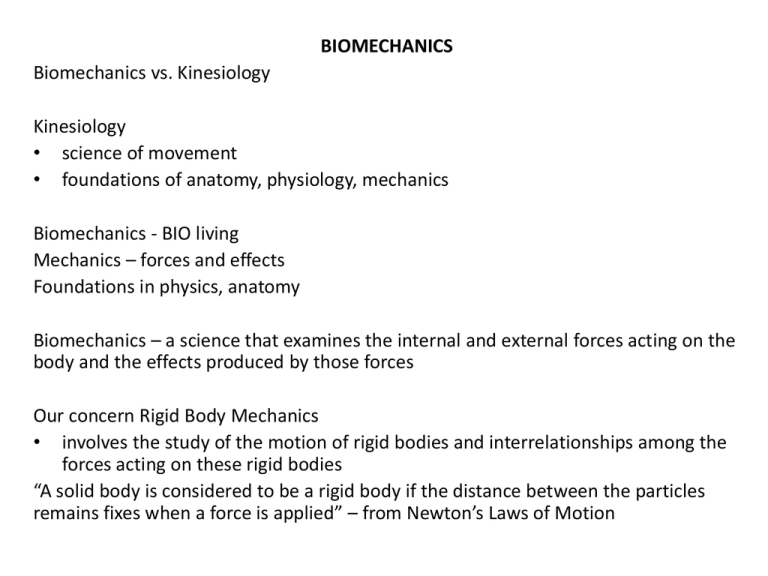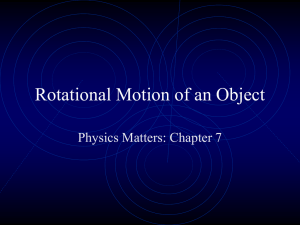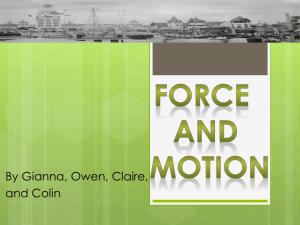Biomechanics
advertisement

BIOMECHANICS Biomechanics vs. Kinesiology Kinesiology • science of movement • foundations of anatomy, physiology, mechanics Biomechanics - BIO living Mechanics – forces and effects Foundations in physics, anatomy Biomechanics – a science that examines the internal and external forces acting on the body and the effects produced by those forces Our concern Rigid Body Mechanics • involves the study of the motion of rigid bodies and interrelationships among the forces acting on these rigid bodies “A solid body is considered to be a rigid body if the distance between the particles remains fixes when a force is applied” – from Newton’s Laws of Motion Fundamental Mechanics Terms • • • • • force – weight vectors – centre of mass scales – pressure mass – inertia balance Vector • mathematical expression representing quantities of both magnitude and direction Scales • mathematical expression representing magnitude only .15g Force • physical quantity which causes (or tends to cause) a change in motion or shape of a body – push/pull effect • four characteristics of force 1. magnitude 2. point of application 3. direction 4. line of action Mass vs Weight • mass is the measure of quantity of matter • weight on the other hand is a measure of force that is relative to the push/pull effect of gravity Mass = mg Weight = mass X gravity (9.8m.sec) Pressure • the distribution of force over an area = FORCE = N or N ------------AREA m2 cm2 1 pascal = N/m2 pascal = pa eg. If a person weighs 400N and the contact for each foot = 100cm2, what is the pressure exerted on the floor standing on two feet? Standing on one foot? Intertia • resistance of a body or object to motion or a change in motion • mass effects inertia – more mass, more inertia • force must be strong enough to overcome this if there is to be movement Centre of Mass (Centre of Gravity) • the centre of mass is the point on the body where everything is balanced • the centre of an object’s weight distribution is known as the centre of mass • for men approximately 57% of standing height • for women approximately 56% of standing height • the approximately height percentage depends upon the morphological type of the person • whenever a body of object is projected into the air, it will always rotate about an axis that goes through the centre of the mass • the pull of gravity on a mass always acts through the centre of mass • the total effect of the force of gravity (9.8m/s) acts upon the objects centre of mass • by examining the way a body’s centre of mass changes, we can identity the nature of forces acting upon that body • when a body is rotating, the axis for rotation is always the centre of mass Movements of Force • causes, or tends to cause, a rotation or turning Movement of force – the force multiplied by the perpendicular distance from an axis of rotation For equilibrium: Where… M = movement w = weight d = distance Stability Basic concepts: Base of Support – more stable when area of base of support is greater Centre of Mass – more stable when centre of mass is further from edge of base of support eg. More stable when line of gravity is within the base of support Stability Basic concepts: • Base of Support – more stable when area of base of support is greater • Centre of Mass – more stable when centre of mass is further from edge of base of support eg. More stable when line of gravity is within the base of support Stable Balance requires: • low centre of mass – wide base of support • centre of mass within base – large mass Want to be Stable -football linesmen -hockey defenseman VS Want to be Unstable -quarterbacks (on balls of feet for quicker movement -sprinters (lift hands and topple forward) Maximal Effort • involves maximal force, acceleration/velocity Force – push/pull causing, or tending to cause, motion Acceleration – rate of change in velocity - measured in meters per second squared (m/sec2) Velocity – rate of change of place or position - basically speed with a directional component - measured in meters per second (m/sec) Biomechanics of Sport • human body is made up of a series of segments linked at joints • eg. Arm: brachium forearm hand Leg: thigh calf/shank foot • muscles crossing each joint cause segments to rotate about an axis • if muscles forces of hip, knee and ankle are properly summed and timed, then the maximal thrust of a ball kick, jump run, etc is achieved • if direction is correct, maximum speed, height or distance is achieved • if the force at one joint is not maximum, or is out of sequence, maximum performance is compromised because “Principle of Continuity of Joint Forces” rules have been violated Levers • every lever requires a centre of rotation (axis, fulcrum, turning point) a force and a resistive load 1st Class Levers (very versatile) • occurs when axis is between the force and the resistance • crowbar, paddling, teeter totter, hammer removing nail 2nd Class Levers (advantage to user in force) • resistive load found between the axis and the force • nutcracker, wheel barrow, rowing, deltoid 3rd Class Levers • force between resistance and axis • shovelling, fishing (with stomach holster) • most implements in sporting events (batting) * most muscoskeletal actions are 3rd class eg. adduction of pectoral girdle Human Motion Newton’s Laws of Motion that govern human movement Newton’s first Law of Motion (Law of Inertia) • “every body will remain in a state of constant motion or rest unless acted upon by an outside force” • eg. if no forces are acting upon a skater, he/she would glide forever • forces preventing that are air resistance, friction, gravity Newton’s second Law of Motion (Law of Acceleration) • states that force is proportional to acceleration, providing that mass is constant • acceleration is directly proportional to force and inversely proportional to mass of object Newton’s third Law of Motion (Law of Action/Reaction) • states “for every action force, there is an equal and opposite reaction force” • eg. direction of applied force should be opposite direction of motion Skills of Maximum Force • those skills that involve slower movements at high intensity • several muscles contract simultaneously to exert maximum force • eg. squat in weight lifting, slapshot Skills of Maximum Velocity • performed sequentially • larger joints first, followed by smaller joints • faster joints (smaller) make contribution when others have reached peak speed • eg. baseball throw, batting Combination/Intermediate Skills • combination of both force and velocity • include overhead pattern skills • eg. spike, tennis serve, javelin • important body movements – sideway trunk rotation, maximum lateral rotation at shoulder before medial rotation Linear Motion • movement of object in a straight line or along a straight pathway Concepts Momentum – amount of motion an object/athlete has developed - linear momentum depends on mass and velocity - amount calculated by m X v Impulse – application of force over time to change amount of momentum - calculated as F x length of time applied - the greater the applied impulse, the greater the increase in velocity Joint R.O.M – amount of movement at each joint - i.e. whether knee moved at 10 R.O.M. or 90 Streamlining – object or athlete being as smooth as possible to allow water/air to flow over -minimize surface area Types/States of Motion STATES 1. Stationary Motion • stable motion • body in balance, no significant movement 2. Linear Motion • movement in straight line or path – bobsled down a track • usually measured in how far/how fast 3. Angular Motion • movement where body or body part undergoes rotation/circular • eg. Elvis Stoiko’s Quad – Triple feat TYPES 1. Angular/Rotary • object turning about an axis • not through centre of gravity, eg. hold a book corner down and spin it 2. Translatory • whole object moved from one place to anouther • can be Rectilinear – weight of body with all parts moving in the same direction, same distance, same speed, eg. somersault • OR • can be Curvilinear – object travelling about a curve NOT circular path called parabolic curve, eg. javelin throw Angular Motion • always occurs around imaginary “axis of rotation” • when somersault axis is in contact with the ground and therefore there is a successive number of axis of rotation • an airborne body’s axis of rotation is always the centre of gravity • all balls/throwing implements have axis of rotation Angular Velocity • refers to velocity of athlete, body segment, object in angular motion • measured in degrees/second, eg 360/sec Off Centre Forces • pass through centre of gravity at an angle • cause torque, ie. wrestler prying on the shoulders of apponent Projectile Motion • distance travelled is dependant on velocity of object at release, height of release and opposing forces • two of them are : air/wind resistance, :gravity • optimal angle for release is 45 degrees • as air resistance increases the angle is decreased in order to increase the horizontal component Magnus Effect • air travelling around flight of body ANGULAR MOTION overhead displaying “Magnus Effect” Velocity • rate of change in distance over a period of time V = d/t (m/sec) Acceleration • rate of change in velocity a = change in velocity change in time F = final I = initial = Vf – Vi tf – ti • if a = 0 → constant velocity a = + (pos) → increasing speed a = - (neg) → decreasing speed Momentum • linear motion Principles of Linear Momentum • momentum is conserved unless acted upon by external forces • predicts outputs of input situations • total momentum before collision = total momentum after collision momentum = mass X velocity (kg*m/sec) Impulse • creation of an impulse creates momentum • impulse → change of momentum • I = Ft -increase impulse by increasing force or time (theoretically) good jumpers however, increase impulse with an increase in force and decrease in time due to the elasticity of the muscles I = change in momentum Ft = Mf – Mi Ft = Mvf – Mvi F = Mvf – Mvi --------------t ***important because: large forces need to be absorbed over time during impact or landing to prevent injuries skills such as: jumping and catching increase R.O.M., increase time Force problems and solutions overhead Problems • 1. If two wrestlers collide, weights 90kg and 100kg, that are moving from opposite directions @15m/s and 9m/s respectively, what is the total momentum before and after the collision? Which direction would the two wrestlers move if they remained in contact? At what final speed? • 2. A baseball player is running home at a velocity of 7.5m/s, he slides to rest 0.8 seconds later. What is the rate of change in velocity (- acceleration)






